Page 359 of 521
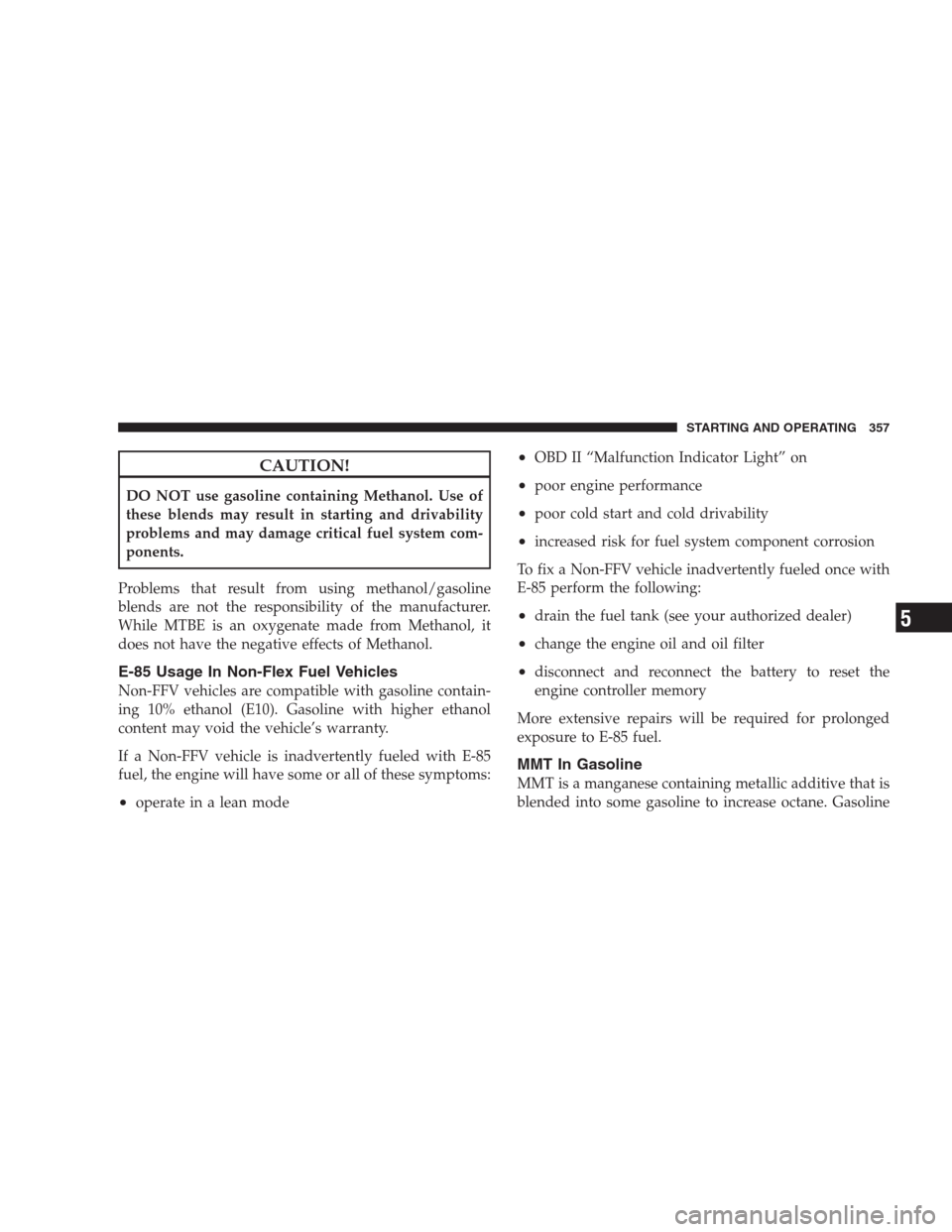
CAUTION!
DO NOT use gasoline containing Methanol. Use of
these blends may result in starting and drivability
problems and may damage critical fuel system com-
ponents.
Problems that result from using methanol/gasoline
blends are not the responsibility of the manufacturer.
While MTBE is an oxygenate made from Methanol, it
does not have the negative effects of Methanol.
E-85 Usage In Non-Flex Fuel Vehicles
Non-FFV vehicles are compatible with gasoline contain-
ing 10% ethanol (E10). Gasoline with higher ethanol
content may void the vehicle’s warranty.
If a Non-FFV vehicle is inadvertently fueled with E-85
fuel, the engine will have some or all of these symptoms:
•operate in a lean mode
•OBD II “Malfunction Indicator Light” on
•poor engine performance
•poor cold start and cold drivability
•increased risk for fuel system component corrosion
To fix a Non-FFV vehicle inadvertently fueled once with
E-85 perform the following:
•drain the fuel tank (see your authorized dealer)
•change the engine oil and oil filter
•disconnect and reconnect the battery to reset the
engine controller memory
More extensive repairs will be required for prolonged
exposure to E-85 fuel.
MMT In Gasoline
MMT is a manganese containing metallic additive that is
blended into some gasoline to increase octane. Gasoline
STARTING AND OPERATING 357
5
Page 362 of 521
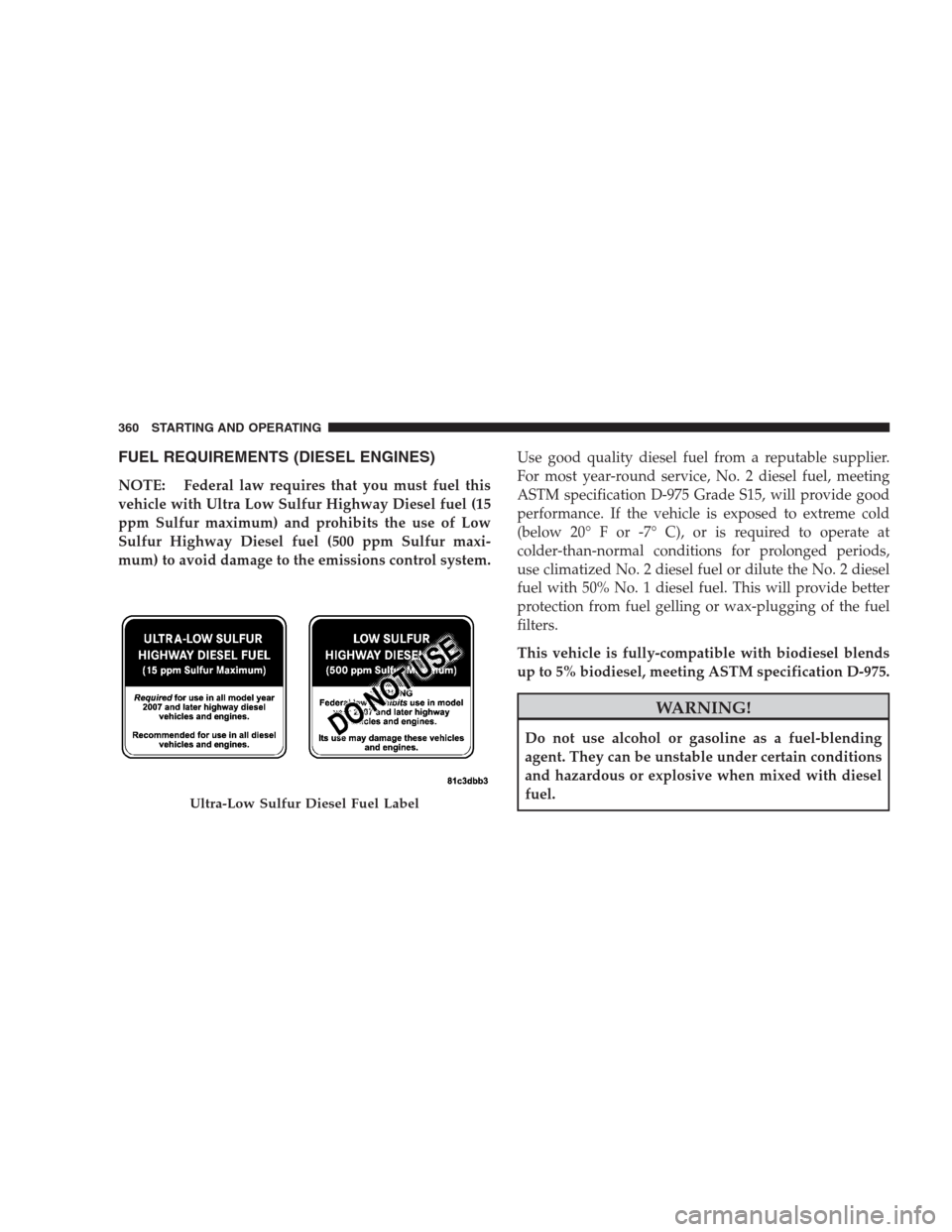
FUEL REQUIREMENTS (DIESEL ENGINES)
NOTE: Federal law requires that you must fuel this
vehicle with Ultra Low Sulfur Highway Diesel fuel (15
ppm Sulfur maximum) and prohibits the use of Low
Sulfur Highway Diesel fuel (500 ppm Sulfur maxi-
mum) to avoid damage to the emissions control system.Use good quality diesel fuel from a reputable supplier.
For most year-round service, No. 2 diesel fuel, meeting
ASTM specification D-975 Grade S15, will provide good
performance. If the vehicle is exposed to extreme cold
(below 20° F or -7° C), or is required to operate at
colder-than-normal conditions for prolonged periods,
use climatized No. 2 diesel fuel or dilute the No. 2 diesel
fuel with 50% No. 1 diesel fuel. This will provide better
protection from fuel gelling or wax-plugging of the fuel
filters.
This vehicle is fully-compatible with biodiesel blends
up to 5% biodiesel, meeting ASTM specification D-975.
WARNING!
Do not use alcohol or gasoline as a fuel-blending
agent. They can be unstable under certain conditions
and hazardous or explosive when mixed with diesel
fuel.
Ultra-Low Sulfur Diesel Fuel Label
360 STARTING AND OPERATING
Page 383 of 521
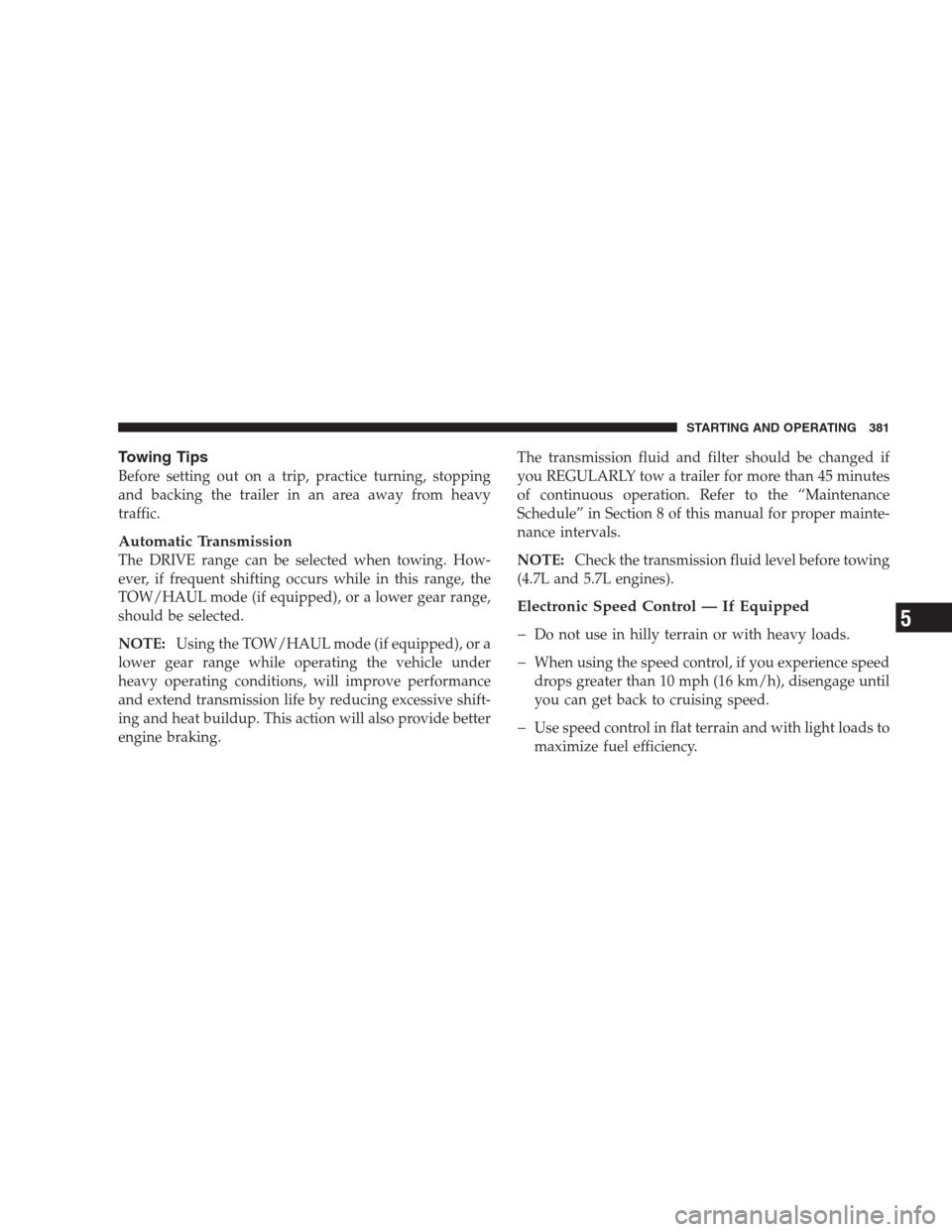
Towing Tips
Before setting out on a trip, practice turning, stopping
and backing the trailer in an area away from heavy
traffic.
Automatic Transmission
The DRIVE range can be selected when towing. How-
ever, if frequent shifting occurs while in this range, the
TOW/HAUL mode (if equipped), or a lower gear range,
should be selected.
NOTE:Using the TOW/HAUL mode (if equipped), or a
lower gear range while operating the vehicle under
heavy operating conditions, will improve performance
and extend transmission life by reducing excessive shift-
ing and heat buildup. This action will also provide better
engine braking.The transmission fluid and filter should be changed if
you REGULARLY tow a trailer for more than 45 minutes
of continuous operation. Refer to the “Maintenance
Schedule” in Section 8 of this manual for proper mainte-
nance intervals.
NOTE:Check the transmission fluid level before towing
(4.7L and 5.7L engines).
Electronic Speed Control — If Equipped
�
Do not use in hilly terrain or with heavy loads.
�When using the speed control, if you experience speed
drops greater than 10 mph (16 km/h), disengage until
you can get back to cruising speed.
�Use speed control in flat terrain and with light loads to
maximize fuel efficiency.
STARTING AND OPERATING 381
5
Page 405 of 521
MAINTAINING YOUR VEHICLE
CONTENTS
�Engine Compartment – 3.7L.............. 406
�Engine Compartment – 4.7L.............. 407
�Engine Compartment – 5.7L.............. 408
�Engine Compartment – 3.0L Diesel......... 409
�Onboard Diagnostic System — OBD II...... 410
▫Loose Fuel Filler Cap Message........... 410
�Emissions Inspection And Maintenance
Programs............................ 411
�Replacement Parts..................... 413�Dealer Service........................ 413
�Maintenance Procedures................. 413
▫Engine Oil......................... 414
▫Engine Air Cleaner Filter............... 417
▫Maintenance-Free Battery.............. 418
▫Air Conditioner Maintenance............ 419
▫Body Lubrication.................... 420
▫Windshield Wiper Blades............... 421
▫Adding Washer Fluid................. 421
7
Page 418 of 521
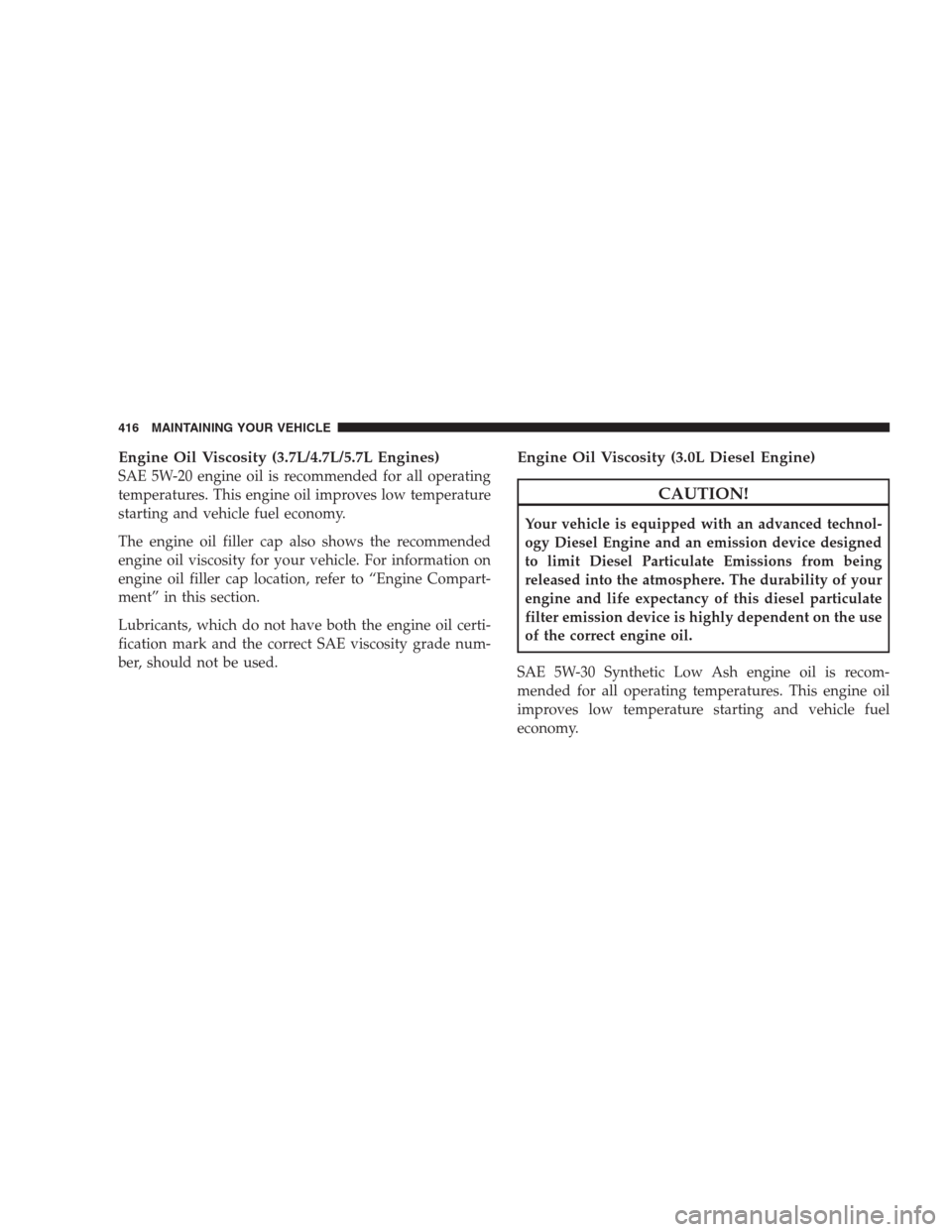
Engine Oil Viscosity (3.7L/4.7L/5.7L Engines)
SAE 5W-20 engine oil is recommended for all operating
temperatures. This engine oil improves low temperature
starting and vehicle fuel economy.
The engine oil filler cap also shows the recommended
engine oil viscosity for your vehicle. For information on
engine oil filler cap location, refer to “Engine Compart-
ment” in this section.
Lubricants, which do not have both the engine oil certi-
fication mark and the correct SAE viscosity grade num-
ber, should not be used.
Engine Oil Viscosity (3.0L Diesel Engine)
CAUTION!
Your vehicle is equipped with an advanced technol-
ogy Diesel Engine and an emission device designed
to limit Diesel Particulate Emissions from being
released into the atmosphere. The durability of your
engine and life expectancy of this diesel particulate
filter emission device is highly dependent on the use
of the correct engine oil.
SAE 5W-30 Synthetic Low Ash engine oil is recom-
mended for all operating temperatures. This engine oil
improves low temperature starting and vehicle fuel
economy.
416 MAINTAINING YOUR VEHICLE
Page 458 of 521
FLUIDS AND CAPACITIES
U.S. Metric
Fuel (Approximate)
3.7/4.7/5.7L Gasoline Engines 21 Gallons 79 Liters
3.0L Diesel Engine 22 Gallons 83 Liters
Engine Oil with Filter
3.7 Liter Engine (SAE 5W-20, API Certified) 5 Quarts 4.7 Liters
4.7 Liter Engine (SAE 5W-20, API Certified) 6 Quarts 5.7 Liters
5.7 Liter Engine (SAE 5W-20, API Certified) 7 Quarts 6.6 Liters
3.0 Liter Diesel Engine (SAE 5W-30 Synthetic, API Certified
Low Ash)10 Quarts 9.5 Liters
Cooling System *
3.7 Liter and 4.7L Engine (MOPAR�Engine Coolant/Antifreeze
5 Year/100,000 Mile Formula) — Without Rear Heat12.7 Quarts 11.8 Liters
3.7 Liter and 4.7L Engine (MOPAR�Engine Coolant/Antifreeze
5 Year/100,000 Mile Formula) — With Rear Heat14 Quarts 13.2 Liters
5.7 Liter Engine (MOPAR�Engine Coolant/Antifreeze 5
Year/100,000 Mile Formula) — Without Rear Heat15.2 Quarts 14.4 Liters
456 MAINTAINING YOUR VEHICLE
Page 461 of 521
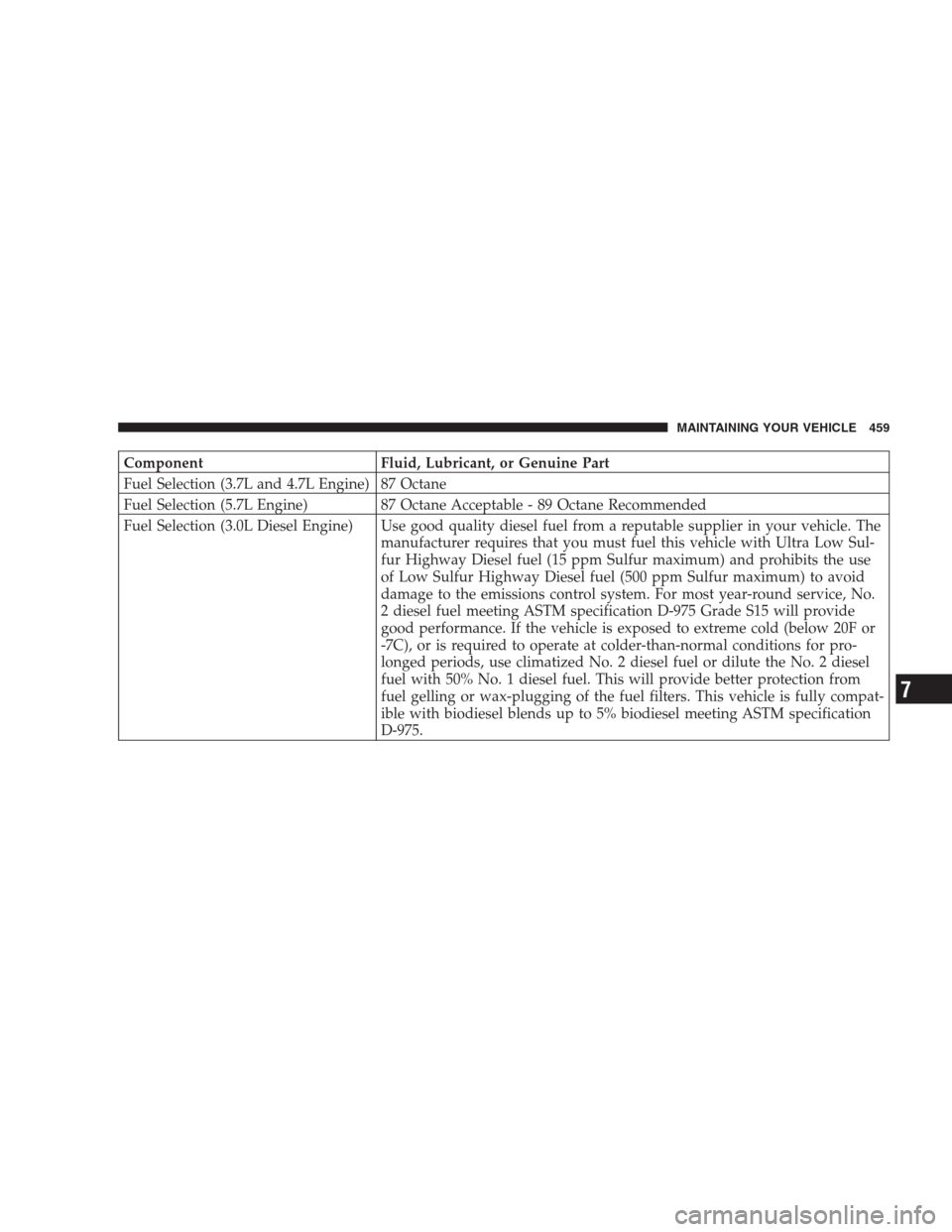
Component Fluid, Lubricant, or Genuine Part
Fuel Selection (3.7L and 4.7L Engine) 87 Octane
Fuel Selection (5.7L Engine) 87 Octane Acceptable - 89 Octane Recommended
Fuel Selection (3.0L Diesel Engine) Use good quality diesel fuel from a reputable supplier in your vehicle. The
manufacturer requires that you must fuel this vehicle with Ultra Low Sul-
fur Highway Diesel fuel (15 ppm Sulfur maximum) and prohibits the use
of Low Sulfur Highway Diesel fuel (500 ppm Sulfur maximum) to avoid
damage to the emissions control system. For most year-round service, No.
2 diesel fuel meeting ASTM specification D-975 Grade S15 will provide
good performance. If the vehicle is exposed to extreme cold (below 20F or
-7C), or is required to operate at colder-than-normal conditions for pro-
longed periods, use climatized No. 2 diesel fuel or dilute the No. 2 diesel
fuel with 50% No. 1 diesel fuel. This will provide better protection from
fuel gelling or wax-plugging of the fuel filters. This vehicle is fully compat-
ible with biodiesel blends up to 5% biodiesel meeting ASTM specification
D-975.
MAINTAINING YOUR VEHICLE 459
7
Page 479 of 521
•Check the windshield washer solvent and add if
required.
Once a Month
•Check tire pressure and look for unusual wear or
damage.
•Inspect the battery and clean and tighten the terminals
as required.
•Check the fluid levels of the coolant reservoir, brake
master cylinder, and power steering and add as
needed.
•Check all lights and other electrical items for correct
operation.
At Each Oil Change
•Change the engine oil filter.
•Inspect the brake hoses and lines.
•Inspect for the presence of water in the fuel filter/
water separator unit.
CAUTION!
Failure to perform the required maintenance items
may result in damage to the vehicle.
Required Maintenance Intervals
Refer to the Maintenance Schedules on the following
pages for the required maintenance intervals.
MAINTENANCE SCHEDULES 477
8
M
A
I
N
T
E
N
A
N
C
E
S
C
H
E
D
U
L
E
S